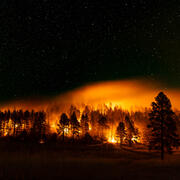Tree Rings

Detailed Description
The secret lives of... trees? Trees can live for hundreds and sometimes thousands of years. As they grow, they add new layers of growth – or tree rings – that scientists can study to learn about the tree’s life. The width of tree rings often reflects the factor most influencing growth from one year to the next depending upon where the tree lives.
Thicker rings often mean heavy rain or snow allowed more growth during that year.
Thinner rings often mean less rain or snow, and thus less growth.
Scarred or lopsided rings could indicate the tree got hit by an avalanche or some other event that the tree had to recover from.
Scars in the rings can also record past fires.
By studying rings in individual trees and through comparisons between trees, paleoclimate researchers can learn about past changes in temperature, precipitation, fires, insect outbreaks, and hazards like avalanches and earthquakes. For example, fire scars can tell us the year, season, size, frequency, severity and climate relationships of fires that happened long ago.
With the help of tree rings, scientists have been able to reconstruct environmental changes thousands of years into the past!
Find more Climate Illustrations here.
Sources/Usage
Public Domain.



